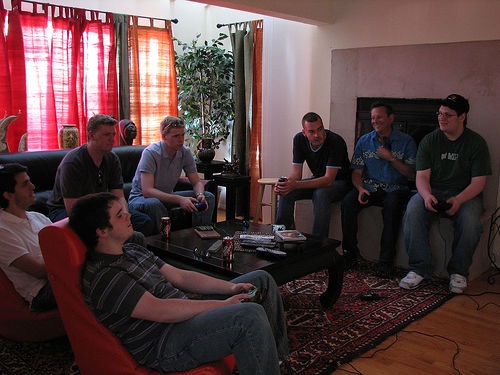
I was poking around the RES website last night and stumbled on a short interview with Keita Takahashi, designer of the iconoclastic Katamari Damacy duet of video games, perhaps my favorite, you know — modern video game.
I’m not a huge video gamer. I play when I’m really in need of a momentary diversion. I work at home a large portion of the time, at a whacky stand-up desk because I’m afraid that a sitting desk will absorb me so much that I would never get the umpf to push away and stand up (as was the case when I tried to have a normal human job). But when I want a diversion, I want something frenetic and weird. I can play a couple of rounds of Katamari for 8 minutes a piece and it’s like an alpha-geek’s stretching exercise. Seriously.
Kind of. I Love Katamari because it isn’t it’s own project. I have plenty of those already, and each becomes an excuse not to start a WoW experiment to see what all the noise is about.
Now I read a couple of interviews in the BBC and RES about Keita Takahashi and like the game even more because it embodies the dynamic within video game culture that gives me a bit of dyspepsia.
Takahashi describes how video game design doesn’t wholly capture his attention, which is probably a systemic thing, it sounds like. His approach sounds like that of someone who will always be an iconoclast, wherever he goes — doing what others are not in a particular field or practice culture. When video games are largely about racing, fighting, role-playing or shooting, he makes one on his own that’s about rolling stuff up.

I also appreciate Takahashi’s perspective on how games can become a part of the tactile and tangible experience of being in the normal, human physical world. Somehow, at a normative level, I think that the kinds of social practice norms that can be breeched or experimented with in the experienced environments of the game world need to be worked on within the physical world as well. That is, if games and play can become frameworks for lightly experimenting with new kinds of social formations, and if those new kinds of social formations can become new ways to inhabit the world — that is, co-habit with less of a deliterious impact, and in a more sustainable, life-affirming way
“I realized while making videogames that walking around in a large space with my own legs, touching objects with my own hands, and feeling something with my own body are sensations that are much more fantastic than moving a controller while sitting in one place,” he says. “Videogames are fine, but they seem a bit like a roundabout way of having fun. I also think it’s kind of a drag that they require electricity to play.”
Katamari anticipates the kind of old school playground play that I hope electronic/pervasive games are able to get to. Like, I’d rather have that casual mode of game play that happens while out in the real world, and reflects in some fashion the charisma of local activities or local objects. That, in my opinion, is where the opportunities for pervasive play lie — game & play experiences off of the sofa and in the real world.
This is not a move to fetishize the old playground style of play as much as it is a move to
1) Open up new game design challenges — screens are really last century
2) Get into the more kinesthetic opportunities of play design, created by the plummeting expertise and costs that used to go along with developing novel human-game interfaces. The computer mouse was a project taken up by a large, multi-million dollar research lab. Nowadays, high school kids can make novel game interfaces and interface syntax that couples GPS, or accelerometers or pedometers..in their backyard..with $40 in parts.
Why do I blog this? I love Katamari, but never really delved into the creative brain behind the game and now I did, and this above explains why.
Technorati Tags: katamari damacy, pervasive electronic games, pervasive media, play, video games